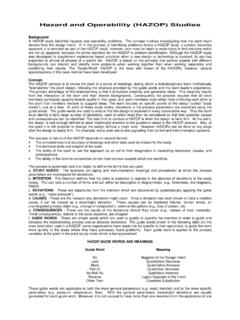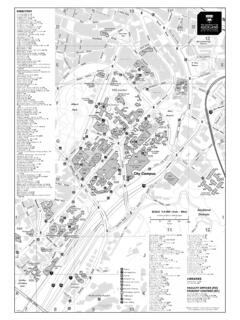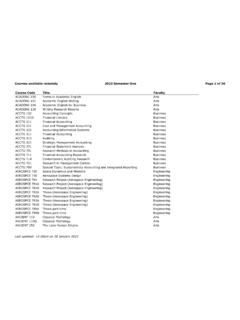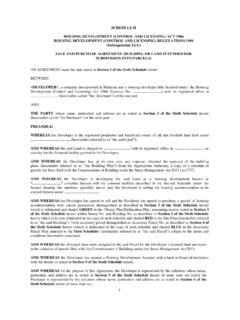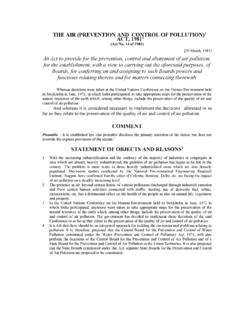Transcription of Safe Stacking and Storage - University of Auckland
1 SafeStackingandStorageARCHIVEP ublished by the Occupational Safety and Health ServiceDepartment of LabourWellingtonNew ZealandISBN 0-477-03449-7 First published: 1985 Reprinted: 1988 Revised for OSH web site: 1999 ARCHIVEC ontentsIntroduction and Scope .. 5A Safe Work System .. 6 Floors and Supporting Surfaces .. 7 Stock Holding Structures .. 8 Pallet Construction and Loading .. 8 Positioning of Stacks .. 9 Size and Shape of Stacks .. 11 Stability and Bonding of Stacks .. 12 Stacking Different Types of Goods .. 13 Rules for Destacking .. 16 Segregation of Stock .. 17 Fire Safety .. 19 Materials Handling Equipment .. 21 Safe Stock Movement .. 22 Automated Storage .. 23 Housekeeping .. 23 Lighting .. 24 Noise .. 24 Protective Clothing and Equipment .. 24 Training of Employees .. 24 Appendix: Incompatible Chemicals .. 25 ARCHIVE5 ARCHIVEW hatever the nature of yourbusiness, it is likely toinvolve the Stacking and Storage ofgoods and materials.
2 Every yearaccidents occur while goods arebeing stacked or destacked and putinto or taken out of Storage . Manyof these accidents are serious someare booklet is designed tohelp employers and employees todevelop safe and effective methodsfor Stacking and Storage and so meettheir obligations under health andsafety is an enormous varietyof Storage systems and stackingmethods in use today. Materialshandling equipment, too, isextremely diverse, ranging fromhand trolleys through various typesof forklift truck to sophisticatedwarehouse , this booklet cannotdeal with all these in , it does set out the generalrequirements and principles for safestacking and Storage which applyirrespective of the particular advice in this booklet isintended to cover all types of goodsand materials, with the exception oftimber and loose bulk materials suchas sand or grain, which are thesubject of separate publicationsissued by the Department of , it does not cover the storageof dangerous goods and explosiveswhich are subject to.
3 The Dangerous Goods Act 1974 The Dangerous Goods Regula-tions 1958 The Dangerous Goods Class 2 Gases Regulations 1980 The Explosives Act 1957 The Explosives on the legislativeprovisions covering these goods canbe obtained from the OccupationalSafety and Health substances notfalling within the above legislation,should be stored in accordance withthese and ScopePlatform truckHand truck6 ARCHIVEA Safe Work SystemEmployers must take allreasonable steps to ensure thatall goods, materials, substances andequipment in workplaces are sostacked, stored, secured, and keptthat they do not constitute a dangerto persons in their vicinity during thecourse of daily operations and in steps should ensure theseitems cannot, whether of their ownaccord, or by virtue of any externalforce (intentionally applied orotherwise), so flow, move, roll, orcollapse, as to constitute a danger topersons in their workers who are or may beresponsible for Stacking , storing,securing, or keeping any goods,materials, substances, or equipmentrequire full training in safe methodsof doing the great diversity ofgoods and materials to be stored, andthe wide range of Storage methodsand handling equipment in use, howcan these obligations best be met?
4 The answer lies in developinga safe system of work that willintegrate the three main componentsof people, materials and machinerywithin a safe and healthy workingenvironment. We shall look at eachof these in , of course, are thecritical factor. In safety and healthwe are looking mainly at injury anddamage to people (concepts of losscontrol and risk management are notforgotten). Also, it is largely peoplewho perpetrate such injury safe work system relies on:(a) Adequate training and instruc-tion for all the workforce;(b) Comprehensive planning, incor-porating the views and opinionsof those who will operate thesystems whenever possible;(c) Adequate supervision and con-trol; and(d) Adequate information to enablethe workforce to carry out theirtasks in a safe and healthy way of covering the aboveis to determine the important criteriafor safety and to set specificparameters which may be used, suchas planning, the provision ofinformation, training and instruction,and to set the framework forsupervision and basic materials handlingand Storage systems common to awide range of stores and warehousesare pallets and racking associated directlywith pallets occur for five mainreasons:(a) Poor pallet design;(b) Poor pallet construction.
5 (c) Use of an unsuitable pallet forthe load or Storage method;(d) Continued use of damaged pal-let; and(e) Bad and Supporting SurfacesThere are basically six reasonsfor a racking system failure, eitheracting singly or in combination:(a) Design fault rack is inher-ently unsafe;(b) Installation fault;(c) Materials handling equipmentfault;(d) Materials handling equipmentoperator fault;(e) Supervision and control fault;and(f) Store or warehouse used in the wrong place by thewrong essential need is toincorporate environmentalconsiderations such as heating,lighting and ventilation into theoverall work OF PRACTICENot all recommendations forsafe Stacking and Storage in thisbooklet may be relevant to yourworkplace. And, there may bespecial conditions or requirementsin your workplace that this bookletdoes not cover in detail. It isrecommended that companiesprepare their own in-house code ofpractice for Stacking and Storage ,taking into account the particularmaterials handling and storagesystems in safe load for every floorshould be known and strictsupervision should be exercised toprevent this limit being a general rule, a level flooris essential.
6 However, where largestacks are regularly built, it is anadvantage if the floor on the site foreach stack is given a fall to the centrefrom all , concrete or othersurfacing may be required to supportstored materials off the or surfaces required toEQUIPMENTB ecause of the bewilderingrange of equipment available in anincreasingly competitive market, itis better to simplify the reasons forfailure. Basically, accidents occurbecause of the wrong equipmentsupport stacks, shelving, racks orother means of Storage should becapable of sustaining the intendedload together with shock there is a possibility of thestored material becomingwaterlogged through rain or afterextinguishing a fire, due allowanceshould be made for this extra supporting surface should alsobe sufficiently strong to withstandthe effects of any damage to ordeterioration of stored should be of soundconstruction, and be ofadequate strength for the loads andconditions under which they areused.
7 Where pallet loads are stackedtier on tier, the lower pallets shouldbe of suitable strength and in goodcondition and the unit loads mustbe able to support the weight Holding StructuresRacks, shelving, bins, hoppersand other structures for thestorage of materials should beadequately designed to support andcontain the materials for which theyare used. Allowance should be madefor the possibility of stored materialsbecoming waterlogged, and forshock loads from placing materialsor from accidental contact byhandling partitions are used toincrease Storage capacity, or toseparate stored materials, theyshould be adequately designed andbe of sufficient strength to containthe stored material partitionsshould be used between stored itemsof differing vulnerability to corners or ends of shelvingand racks should be protected fromdamage by forklift trucks ormechanised equipment by steelposts, angle irons or other Construction and LoadingStorage bin Fire-protective partitionsPallet9 ARCHIVES tacks should not be built within450 mm of a wall.
8 Most buildingand party walls are not retainingwalls and may not withstand thepressure set up by stacks laid againstthem. A 450 mm gap between thestack and the wall also enables theconstruction and the condition ofstacks to be stability of stackedpallets or unit loads should bemaintained by suitable bonding,avoiding excessive stack heights,to ensure that the contents of anypallet or unit load cannot stability and structural strengthof each pallet or unit load shouldbe assured by bonding, taping,shrink wrapping or other pallet or unit loads ofcartons or sacks are stacked, careshould be taken that they are notdamaged by or other supports usedfor forming unit loads should beregularly inspected for damage andwear. Items which could causedamage to materials should be takenout of use until repaired, or should be made toNZS 2010: 1970 Specification forflat pallets for materials of StacksStacks should not be createdwhere any part will be within mof a rail track.
9 This clearance shouldbe continued all the way along care should be taken ifthe Storage area is subject tovibration from rail or road traffic,outside or inside the for loading10 ARCHIVECare should also be taken instacking material in the vicinity ofmachinery or operations whichcause vibrations. Some objects areliable to creep and lose stabilityunder the influence of or bales made of syntheticmaterials are particularlysusceptible, especially when firstused. (Impregnation with wax canhelp to overcome this problem.)Stacks, shelving and otherfixtures for holding or storingmaterials should be so laid out anddesigned that there is sufficientaccess for safe loading andunloading by either manual ormechanical areas should bespecifically designated, be clearlymarked, and be in the charge of aresponsible employee. Aisles shouldbe clearly marked, be of ample widthfor the type of Storage , and be keptfree from obstacles and wastematerials.
10 Stacks should not becreated which will block gangways,aisles, walkways, thoroughfares, andparticularly doors and should have clearspaces of at least 1 m on all sides,apart from walls, where a 450 mmspace should be allowed. Goodsmust not be stacked within 1 m ofthe ceiling, roof or sprinkler areas and heights ofstacks should be kept as small ascircumstances permit. Goods shouldbe kept well clear of light fittings,heating pipes and appliances,firefighting and alarm equipment,and stack, shelving, fixture orother means of Storage should beplaced in a position, or extended inheight, so that a person climbing onto it or removing stored goods, eithermanually or mechanically, can comeinto contact with live electricalwiring or unfenced material should be loadedor unloaded from stacks, shelving orfixtures if there is a risk of workersdirectly or indirectly contactingunfenced machinery, or touchinglive electrical wiring, until thatClearways in a store.



